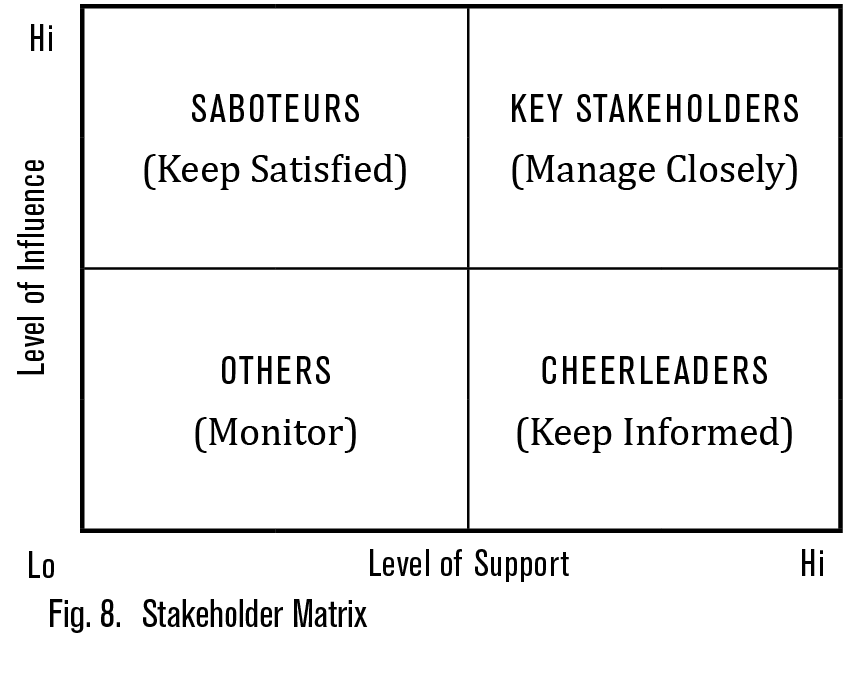Online Readings
Some of the content is provided as online readings. These are much smaller file sizes than videos and other media, which means that the content loads faster. The readings include practical instructions, concepts, pictures, key points and additional reading suggestions. The following content is an example of information that would be contained in a reading.
Analyse Stakeholders
Once the stakeholders have been identified, it is important to analyse the stakeholders' levels of commitment, influence and support for the project to have a clear profile of each stakeholder. The analysis can be quick and simple, or a detailed analysis can be performed for each stakeholder.
Basic Analysis
In some situations, it is ineffective to conduct a detailed stakeholder analysis. For instance, simple, low-risk projects with few stakeholders may not need a detailed stakeholder analysis to be successful. In these cases, a basic analysis is appropriate. To conduct a basic analysis, focus on the stakeholder's sentiment or attitude about the project, their expectations, any quick wins that can be gained, and any issues that should be addressed immediately.
Sentiment
Determining the stakeholder's sentiment about the project involves assessing their attitude about the project and classifying the stakeholders. Stakeholders with a positive attitude about the project would be classified as allies; a negative attitude would be opponents; and the remainder would be neutral. Allies could be leveraged to promote the project and help win over other stakeholders who may be useful. Alternatively, allies may only need to be shown consideration or have their expectations addressed. In contrast, powerful opponents should also be addressed. For instance, you should prioritized finding quick wins to help bring the opponents around or reduce their opposition to the project. The stakeholders' sentiment can be plotted in a simple table using words (Ally, Neutral, Opponent), letters (A, N, O), or colours (green, yellow, red) to indicate their attitude about the project.
|
Stakeholder |
Attitude |
|
Stakeholder A |
Ally |
|
Stakeholder B |
Ally |
|
Stakeholder C |
Neutral |
|
Stakeholder D |
Ally |
|
Stakeholder E |
Opponent |
|
Stakeholder F |
Opponent |
Quick Wins
After the stakeholders' attitudes about the project are determined, consider what can be done to quickly satisfy each stakeholder by considering their expectations and how these expectations can be addressed. Remember, however, that their expectations might be unexpressed or even hidden. Typically, the expectations of allies will already be addressed, so the focus will tend to be on neutrals and opponents, but the allies must not be ignored. Try to develop actions that can be taken quickly to address their expectations, and before moving on to long term issues and concerns.
Long Term Issues and Concerns
While defining quick wins is valuable for getting stakeholders' support, it is equally important to know what their longer term issues or concerns are, and determining how to reduce or eliminate these issues. The process to analyse long term issues and decide how to solve them will require input from the team, management and other stakeholders, and it should be prioritized with the other work on the project. The basic analysis table can be expanded to include the quick wins and long term issues to complete the basic analysis.
|
Stakeholder |
Attitude |
Expectation |
Quick Wins |
Long term issues/Concerns |
- Table: Basic Stakeholder Analysis
Detailed Stakeholder Analysis
While a basic stakeholder analysis is helpful to quickly assess in simple situations, a more detailed analysis is valuable for more complex, high risk projects with many and diverse stakeholders. In a more detailed analysis, you should determine each stakeholder's current and desired level of engagement with the project, their level of influence over the project, and their level of support for the project. The results of this analysis will be used to plan how to engage each stakeholder proactively.
Assess Engagement Level
To start a detailed stakeholder analysis, determine each stakeholder's current level of engagement with the project. Levels of engagement are based on the stakeholder level of awareness and support for the project. The different levels are:
• Unaware - Stakeholders who don't know about the project or its potential affect on them.
• Resistant - Stakeholder who are aware of the project, but oppose any changes that could come about as a result of the project.
• Neutral - Stakeholders who are aware of the project but ambivalent about it.
• Supportive - Stakeholders who are aware of the project and actively support the work and its effects.
• Leading - Stakeholders who are actively engaged and working to ensure that the project is successful.
Continuing the stakeholder register, each stakeholder's current and desired level of engagement with the project should be determined. Similar to the previous analysis of the stakeholders' sentiment, the stakeholders' engagement level can be plotted in a simple table using words (Unaware, Resistant, Neutral, Supportive, Leading) or letters (U, R, N, S, L) in columns for current and desired status. Identifying any gaps between current and desired levels will help plan the activities to effectively engage the stakeholder.
|
Stakeholder |
Current |
Desired |
|
Stakeholder A |
Unaware |
Supportive |
|
Stakeholder B |
Neutral |
Supportive |
|
Stakeholder C |
Resistant |
Neutral |
|
Stakeholder D |
Supportive |
Supportive |
|
Stakeholder E |
Leading |
Leading |
|
Stakeholder F |
Neutral |
Supportive |
Alternatively, a stakeholder engagement assessment matrix can be used, where C represents the stakeholder's current level of commitment and D represents the desired level.
|
Stakeholder |
Unaware |
Resistant |
Neutral |
Supportive |
Leading |
|
Stakeholder A |
C |
|
|
D |
|
|
Stakeholder B |
|
|
C |
D |
|
|
Stakeholder C |
|
C |
D |
|
|
|
Stakeholder D |
|
|
|
C, D |
|
|
Stakeholder E |
|
|
|
|
C, D |
|
Stakeholder F |
|
|
C |
D |
|
Analyse each stakeholder's degree of influence and support to determine the best way to engage the stakeholder.
Level of Influence
In addition to the stakeholders' engagement level with the project, you must determine each stakeholder's degree of influence over the project. Some stakeholders will be very influential, even to the point that they can create or terminate a project. Others may not have much influence at all. To assess a stakeholder's degree of influence consider their:
• Position in the hierarchy;
• Economic, social or political position;
• Personal connections with influential people;
• Level of expertise;
• Negotiating skills;
• Level of control over resources; and
• Personal charisma.
Level of Support
Determine the level of support that each stakeholder has for the project. Support usually ranges from being very opposed and subverting the project, to
weakly opposed or apathetic and needing persuasion to support the
project, to being weakly supportive and looking for ways to align needs
on the project, and finally those who are very supportive and actively
promoting the project. This is a subjective analysis that is important in determining how the relationship with the stakeholder will be managed.
|
Strongly Opposed |
Weakly Opposed |
Weakly Supports |
Strongly Supports |
|
Actively Against/Subverts |
Needs Persuasion |
Seeks Alignment |
Actively Promotes |
Once you have determined each stakeholder's degree of support and influence, the stakeholder can be plotted on a stakeholder matrix to help determine the best approach to engage each stakeholder.

- Fig. 8. Stakeholder Matrix
Key Stakeholders
Key stakeholders, promoters or champions are those with a lot of influence over and support for the project. They are usually people who have made a substantial investment in the project, either monetarily or personally. Because the key stakeholders have high influence and support, manage the relationship with them very closely. This means keeping them well informed, and taking care to address their expectations.
Cheerleaders
Cheerleaders, advocates or supporters are stakeholders who are strongly supportive of the project, but do not have a lot of influence. To engage cheerleaders, keep them informed about the project to maintain their support for it, and encourage them to promote it.
Saboteurs
Saboteurs, objectors or blockers are stakeholders possessing a lot of influence who have a low level of support for the project, or they may even oppose it. They often come from senior management level, and oppose the project because they see it as taking resources and/or funding away from their own preferred project. The root cause of saboteurs is often traceable to the lack of an objective project selection process.
To manage saboteurs, attempt to keep them satisfied by addressing their concerns by identifying their interests and expectations.
Project managers often make the mistake of simply keeping saboteurs informed, while trying to keep cheerleaders satisfied. Although this is an easy trap to fall into, the most effective approach is to do exactly the opposite; saboteurs need to be satisfied, whereas it is only necessary to keep cheerleaders informed. The problem with trying to address cheerleaders' expectations and interests is that they may not be appropriate for the project. And the problem with only sending information to saboteurs without meeting their expectations, is that they could use the information to further block the project.
Others
Finally, there are other stakeholders, bystanders, or the crowd, who have low influence and low support for the project. Rather than ignoring these individuals, monitor them in case their levels of support or influence change. If this happens, then obtain more information about their interests and expectations to engage them effectively. The goal is to move these stakeholders' levels of support to the right in the matrix.
Integrate with Stakeholder Register
The results of the stakeholder analysis can be integrated with the stakeholder register to be used to plan stakeholder engagement. It is also important to remember that stakeholders' sentiments about the project, and their levels of influence and support can change throughout the project, so regular review of the stakeholder analysis will enable you to manage relationships proactively.
